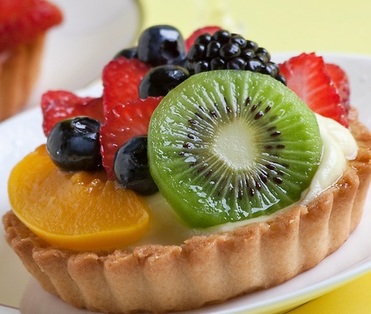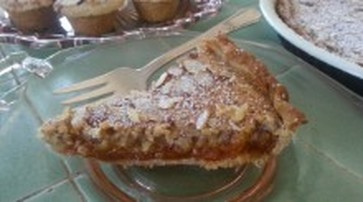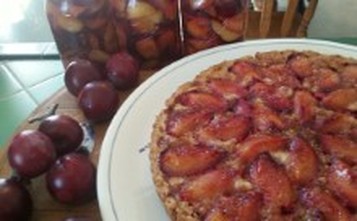To begin with, the class was held in the seaside town of Capitola, in a neighborhood known as the Jewel Box. (My friend Suzi lived for a time on Emerald Street.) It was in Jade Street Park, where one of the rooms was set up like a home economics classroom, with four or five kitchen stations equipped with ovens. The participants were diverse groups of people from the area: girlfriends taking the class together (like us) teenage boys and girls and young families. Everyone was having so much fun, whatever their level of baking experience, and all the tarts were lovely. It was charming to see a dad helping his little girl make a beautiful tart.
And these tarts really were all delicious. The instructor’s main idea was that one basic tart dough could be used successfully for many different tarts. It is a simple press-in dough thus skipping the anxiety of rolled out pastry which makes so many new, and some experienced, bakers fearful of trying tarts and pies. Her recipe couldn’t be easier. Just three ingredients go into the food processor until they form crumbs which are turned into a tart pan and pressed in. It’s been over thirty years since I took this class, and I still treasure the sheaf of spattered recipes. They’ve gone with me to all my bed and breakfast jobs, and I’ve relied on them for family and party desserts year round. When I have an abundance of plums, peaches, or pears, I go right to these recipes. When I need a dessert and I just want to use what I have in the house, I use the Chocolate Pecan recipe.
It was when I wanted to showcase some perfect apricots that I first used the Almond Apricot Tart recipe. Though it isn’t mentioned anywhere in the recipe, the almond portion of the filling is frangipane, defined as a mixture of ground almonds, butter, sugar and eggs that is used to fill a tart. Confusingly, it is sometimes referred to as almond custard or almond pastry cream. Containing eggs, it is technically a custard though it is a very thick mixture which bakes up into a semi-moist solid. I would reserve the term “pastry cream” for the thick egg and dairy custard which is cooked on the stovetop, cooled, then used in a baked tart shell usually topped with fresh fruit, a whole different animal, usually called a fresh fruit tart. (A future blog post will be all about the best pastry cream recipe I’ve found. It’s perfect!)
What you don’t get from the definition is how useful frangipane is to tart bakers. It does several things really well, the most important of which is providing a moisture barrier between the juicy fruit and the crust underneath. The nut mixture adds a textural contrast to the soft fruit while adding richness and flavor. Rose writes of the origins of the filling in our wonderful Bakewell Tart recipe, a traditional teatime sweet made in a rolled tart crust with a layer of jam under the frangipane filling. The Bakewell Tart recipe appears in the British Afternoon Tea menu in the World of Tea Parties section of our website, www.myteaplanner.com. A fruit tart with frangipane perfectly straddles the line between rustic fruit dessert and elegant pastry. The tart is welcomed with delight everywhere it is presented, traveling well in its removable-bottomed tart pan or looking luscious atop a cake stand.
Speaking of the removable-bottomed tart pan, the equipment for tarts is minimal. For miniature tarts, a tart tamper is nice, but I did without one for years. A pastry brush is needed to apply a thin layer of glaze (usually apricot jam) to the top of the baked tart, to put an attractive shine on the somewhat dull cooked fruit. If you are making a prebaked tart shell of rolled out dough, a dough-docker is a useful tool to have, but a fork works as well. Ceramic or metal pie weights are used to fill the crust during prebaking, but dried beans can be used to keep the empty tart shell from shrinking, then cooled and stored for your next tart. If you do not have a tart pan, a not-too high sided pie pan may be substituted though it’s not advisable to try to remove the tart from it. I do encourage you to buy a removable-bottom tart pan because removing the sides easily shows off the pretty golden brown fluted edge, adding immensely to the presentation of your tart. And nothing is more charming with tea than individual tarts, so a mini tart pan or two is a good investment.
In tea menus, tarts are traditional because they are delicious and attractive. Miniature tarts fit the afternoon tea menu mandate to keep serving sizes petite and not messy. They are equally pleasing with savory or sweet fillings. A quick glance at our list of recipes show we have clearly made a commitment to tarts. You’ll find Sweet Potato Tartlets, Rhubarb Tart, Shallot and Onion Tart, and Pecan Tartlets to name just a small sample of the tart recipes found in our collection. If this whets your appetite for tarts, do spend so time looking over the many tart recipes found in our book, Sharing Tea: The Road back to Civilization and on our website, www.myteaplanner.com.
I’m very sorry I can’t recall the name of this tart class teacher who made such an impact on my baking. When running a cooking school years later, I tried to stress to the instructors the importance of a title page on their recipe packets for just this reason. Students told me repeatedly that they loved cooking out of their packets from past classes and kept them as treasured parts of their recipe collections, as do I.
- 1 1/3 cup flour
- 1/3 cup powdered sugar
- 10 tablespoons butter (1 stick plus 2 tablespoons) butter, cut into 10 slices
- (Her original recipe called for 1 stick plus 1/3 stick butter which is fine, too)
Preheat oven to 375°F
Special equipment: food processor, tart pan(s)
Makes 1 batch press-in tart dough, enough for one 9” tart or about 20 miniature tarts
- Place all ingredients in food processor and pulse just until ingredients begin to cling together. To test the dough, squeeze a handful of crumbs; if they stay together the dough is ready, if not process until it does.
- Press dough into one 9” tart pan or 20 miniature muffin pans.
- Tart shell may be covered with plastic wrap and chilled for later use, up to 4 days. Or, shell may be par-baked at 375˚F for 15 to 18 minutes, until lightly browned. (It’s not usually necessary to prebake miniature tarts.)
If making the frangipane right after making the crust, there is no need to clean the food processor bowl between use.
- 1 prebaked tart shell
- Frangipane: 1 cup almonds (whole, or slivered, with skins or without: I use whatever I have at hand)
- 2/3 cup sugar
- 2 eggs
- ½ teaspoon vanilla and/or ¼ teaspoon almond extract
- 5 to 7 (depending on size) soft fruits such as apricots, plums, pears, or peaches
- Glaze: ¼ cup apricot jam
Preheat oven to 350°F
Special equipment: food processor, spatula, small microwave-safe bowl, small sieve or tea strainer, small bowl, pastry brush
Makes one 9” tart
- Filling: In food processor work bowl, pulse until almonds and sugar are finely ground. And eggs and extract(s) and process until incorporated. Scrape down sides and pulse to blend.
- Scrape into prebaked tart shell.
- Prepare fruit: if using peaches or pears, peel first. Take apricot, plums, peaches, or pears (or a combination) and halve. Slice halves, keeping the slices together.
- Arrange fruit attractively, keeping the slices together but fanning out slightly, on the frangipane. Press in gently. Add cherries or berries, if desired.
- Bake for 45 to 55 minutes until filling browns, puffs up, and becomes firm. Cool on rack while making glaze.
- Glaze: In microwave-safe bowl, heat apricot jam for 20 to 30 seconds, just until it melts and becomes syrupy. Strain through sieve into a small bowl, discarding solids. Brush glaze on top of tart, concentrating on the cooked fruit.
- Remove side of tart pan and place on serving plate. Serve warm or at room temperature. Store loosely covered at room temperature up to three days but best eaten the day it is made.
Feel free to change the nuts to walnuts or almonds. This is a wonderful dessert for winter holidays but good for chocolate lovers year round. The hint of molasses gives this tart a subtle tang that will have guests enraptured.
- 1 prebaked tart shell
- Filling: 2 eggs
- ¾ cup light corn syrup
- 2 tablespoons molasses
- ¼ cup sugar
- 2 tablespoons melted butter
- 2 teaspoons vanilla
- 3 ounces semi-sweet chocolate, melted
- 1 cup pecans
Preheat oven to 375°F
Special equipment: large bowl, whisk, scraper
Makes one 9” tart
- In large bowl, whisk together eggs, corn syrup, molasses, sugar, melted butter, and vanilla. Whisk in melted chocolate and pecans.
- Scrape mixture into prebaked tart shell and bake for about 20 minutes, or until filling is firm. Cool completely before serving. Store loosely covered at room temperature up to three days or if kitchen is very warm, in refrigerator. Bring to room temperature before serving.




 RSS Feed
RSS Feed